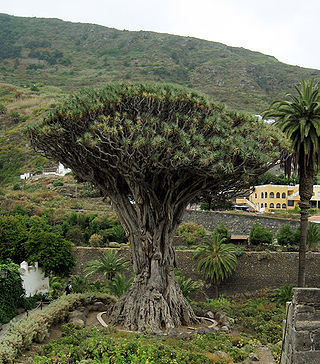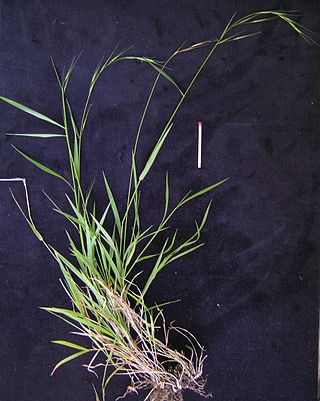
Convolvulaceae, commonly called the bindweeds or morning glories, is a family of about 60 genera and more than 1,650 species. These species are primarily herbaceous vines, but also include trees, shrubs and herbs. The tubers of several species are edible, the best known of which is the sweet potato.

Zygophyllaceae is a family of flowering plants that contains the bean-caper and caltrop. The family includes around 285 species in 22 genera.

The Aizoaceae, or fig-marigold family, is a large family of dicotyledonous flowering plants containing 135 genera and about 1800 species. They are commonly known as ice plants or carpet weeds. They are often called vygies in South Africa and New Zealand. Highly succulent species that resemble stones are sometimes called mesembs.

Dracaena is a genus of about 120 species of trees and succulent shrubs. The formerly accepted genera Pleomele and Sansevieria are now included in Dracaena. In the APG IV classification system, it is placed in the family Asparagaceae, subfamily Nolinoideae. It has also formerly been separated into the family Dracaenaceae or placed in the Agavaceae.

Crinum is a genus of about 180 species of perennial plants that have large showy flowers on leafless stems, and develop from bulbs. They are found in seasonally moist areas, including marshes, swamps, depressions and along the sides of streams and lakes in tropical and subtropical areas worldwide.

The Combretaceae, often called the white mangrove family, are a family of flowering plants in the order Myrtales. The family includes about 530 species of trees, shrubs, and lianas in ca 10 genera. The family includes the leadwood tree, Combretum imberbe. Three genera, Conocarpus, Laguncularia, and Lumnitzera, grow in mangrove habitats (mangals). The Combretaceae are widespread in the subtropics and tropics. Some members of this family produce useful construction timber, such as idigbo from Terminalia ivorensis. The commonly cultivated Quisqualis indica is now placed in the genus Combretum. Many plants in the Quisqualis species contain the Non-proteinogenic amino acid excitotoxin Quisqualic acid, a potent AMPA agonist.

Myoporum is a genus of flowering plants in the figwort family, Scrophulariaceae. There are 30 species in the genus, eighteen of which are endemic to Australia although others are endemic to Pacific Islands, including New Zealand, and one is endemic to two Indian Ocean islands. They are shrubs or small trees with leaves that are arranged alternately and have white, occasionally pink flowers and a fruit that is a drupe.

Heliotropium is a genus of flowering plants in the heliotrope family, Heliotropiaceae. There are around 325 species in this almost cosmopolitan genus, which are commonly known as heliotropes. It is highly toxic for dogs and cats.

Cordyline is a genus of about 24 species of woody monocotyledonous flowering plants in family Asparagaceae, subfamily Lomandroideae. The subfamily has previously been treated as a separate family Laxmanniaceae, or Lomandraceae. Other authors have placed the genus in the Agavaceae. Cordyline is native to the western Pacific Ocean region, from New Zealand, eastern Australia, southeastern Asia and Polynesia, with one species found in southeastern South America.

Pittosporaceae is a family of flowering plants that consists of 200–240 species of trees, shrubs, and lianas in 9 genera. Habitats range from tropical to temperate climates of the Afrotropical, Indomalayan, Oceanian, and Australasian realms. The type genus is Pittosporum Banks ex Gaertn.

Capivari de Baixo is a Brazilian municipality located in the southern region of Santa Catarina. In 2010, it had a population estimated at 21,674 inhabitants. As of 2020, the population was estimated to be at 25,177. From 1991 to 2000, the demographic growth has been of 1,51% yearly, while the national average was of 1,63%. From 2000 to 2010, the demographic growth was of 1,56% yearly, while the national average was of 1,17%. Capivari de Baixo has the largest coal-fired thermoelectric power plant of Latin America, Complexo Termoelétrico Jorge Lacerda.

Diurideae is a tribe of orchid in the subfamily Orchidoideae. It contains about 40 accepted genera. As of April 2018, its division into subtribes remained unclear.

Microlaena is a genus of flowering plant in the family Poaceae, native to from Java through Australia to New Zealand. The genus was established by Robert Brown in 1810.
In the run up for the 2026 Swedish general election to the Riksdag, various organisations carry out opinion polling to gauge voting intention in Sweden. The date range for these opinion polls are from the 2022 Swedish general election, held on 11 September, to the present day. The next election is scheduled for 13 September 2026.
The 2023 season is the 114th season in the history of Sport Club Corinthians Paulista. The season covers the period from January 2023 to December 2023. The pre-season began earlier than usual in December 14, 2022, as the previous season was shorter due to the 2022 FIFA World Cup taking place at the end of the year.
The 2023 season will be the 21st season in the history of Sport Club Corinthians Paulista (women). In addition to the domestic league, Corinthians will participate in this season's editions of the Supercopa do Brasil, Copa Libertadores Femenina and Campeonato Paulista. There will be a mid-season break due to the 2023 FIFA Women's World Cup in July-August.
Thiago Moio Pace also known as Thiago Piraju, is a brazilian football player who plays as a Midfielder for ASD Luogosanto Football club.












